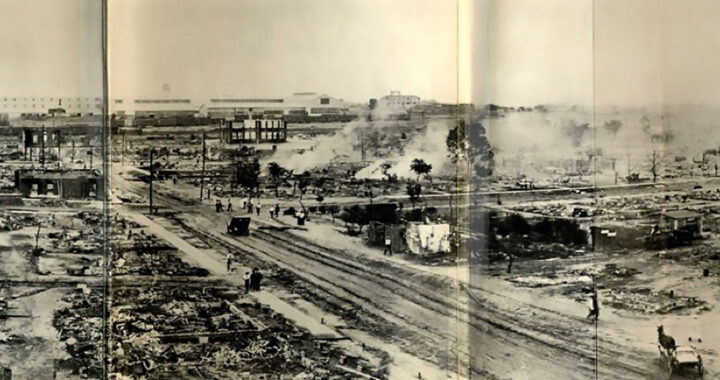The Black Wall Street Massacre, also known as the Tulsa Race Massacre of 1921, is one of the worst acts of racial violence in United States history. It occurred between 31 May and 1 June 1921 and involved white mobs attacking the well-off Black American community in Greenwood District in Tulsa. More than 1000 homes and business establishments were burned to the ground and the death toll ranges from 75 to 100. The massacre and details of the events were deliberately omitted from American history books for decades.
Massacre at the Black Wall Street: Revisiting the Tulsa Race Massacre of 1921
Explaining the Black Wall Street
The Greenwood District in Tulsa in Ohio was dubbed the Black Wall Street because it was home to one of the most self-sufficient and booming Black American communities in the U.S. It boasted hundreds of Black-owned businesses. These include banks, hotels, restaurants, movie theaters, law offices, and newspapers. Residents succeeded in establishing a resilient and thriving middle-class community through entrepreneurship, education, and mutual support.
A combination of Black self-reliance, entrepreneurship, and segregation-driven necessity made the district prosperous. Segregation laws compelled Black residents to build a self-sufficient economy with synergistic business activities and critical social institutions. The district is also near the oil-rich areas of Tulsa. Many Black residents worked in the oil industry or provided goods and services to oil workers. This helped in bringing wealth to the community.
Racial discrimination still persisted in the greater American society during the Jim Crow era. The district existed within a deeply segregated society. Black Wall Street stood as a powerful reminder not only of the economic success of the Black American community but also of the capabilities of Black Americans. This fueled white resentment toward their wealth and success. White residents in Tulsa viewed the community in Greenwood as a threat to the social order.
False Accusation and the Unfolding of the Massacre
The series of tragic events began when Dick Rowland, a nineteen-year-old Black man who worked as a shoe polisher, was accused of assaulting seventeen-year-old white elevator operator Sarah Page in a downtown Tulsa building. The details were unclear and the charges were later dropped but sensationalized newspaper headlines inflamed existing racial tensions. Below are the series of important occurrences that led to the Black Wall Street Massacre:
• Sentiments: Mobs of both Black and white residents congregated outside the courthouse where Rowland was being held. The whites insisted on his lynching while the Blacks arrived to protect him. Both mobs were toe-to-toe with each other.
• Escalation: A confrontation between an armed Black man and a white protester resulted in the death of the white protester. A gunfire also broke out. This ignited the violence. Note that some members of both factions were armed.
• Massacre: The white mob became incensed and began attacking the Greenwood District where they looted and burned Black-owned businesses and homes for the next two days. Firefighters were reportedly turned away at gunpoint.
Aftermath and Historical Legacy
The exact death toll remains unknown. Some estimates suggest that between 75 and 300 people died due to gunfire, arson, and general mob violence. More than 1000 homes and businesses were burned or destroyed. Nearly 10000 people were left homeless. Some families were compelled to relocate to other cities and counties to avoid further violence. More than 6000 Black Americans were also detained in makeshift internment centers.
An all-white grand jury blamed the Black community in the Greenwich District for the lawlessness despite overwhelming evidence indicating otherwise. No white Americans were ever prosecuted for the murders and arson. The incident, especially the massacre, was largely suppressed from historical accounts and rarely discussed in public or in educational settings because of attempts at controlling the narrative, fear of retaliation, and neglect of Black history.
The Black Wall Street Massacre has attracted renewed attention in later years. A state commission was formed in 1997 to investigate and formally document the massacre. Calls for restitution and historical reckoning emerged in 2021 or a century after the incident occurred. Monroe Nichols, the first Black mayor of Tulsa, pitched in June 2025 a reparation package worth USD 100 million for descendants of the victims of the Tulsa Race Massacre of 1921.
FURTHER READINGS AND REFERENCES
- Ellsworth, S. n.d. “Tulsa Race Massacre.” The Encyclopedia of Oklahoma History and Culture. Oklahoma Historical Society. Available online
- Murphy, S. and Associated Press. 3 June 2025. “Tulsa’s First Black Mayor Has a Bold Pitch: A $100 Million Reparations Package for Descendants of the 1921 ‘Black Wall Street’ Massacre.” Fortune. Available online
- Parshina-Kottas, Y., Singhvi, A., Burch, A. D. S., Griggs, T., Gröndahl, M., Huang, L., Wallace, T., White, J., and Williams, J. 24 May 2021. “What The Tulsa Race Massacre Destroyed.” The New York Times. Available online
Photo Credit: Mary E. Jones Parrish/Panorama of the Ruined Area Tulsa Race Riots / 1922 / Public Domain
